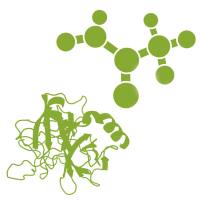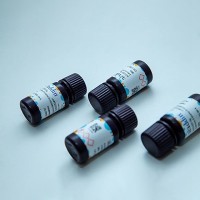Site‐Specific Protein Labeling with SNAP‐Tags
互联网
- Abstract
- Table of Contents
- Materials
- Figures
- Literature Cited
Abstract
Site?specific labeling of cellular proteins with chemical probes is a powerful tool for studying protein function in living cells. A number of small peptide and protein tags have been developed that can be labeled with synthetic probes with high efficiencies and specificities and provide flexibility not available with fluorescent proteins. The SNAP?tag is a modified form of the DNA repair enzyme human O 6 ?alkylguanine?DNA?alkyltransferase, and undergoes a self?labeling reaction to form a covalent bond with O 6 ?benzylguanine (BG) derivatives. BG can be modified with a wide variety of fluorophores and other reporter compounds, generally without affecting the reaction with the SNAP?tag. In this unit, basic strategies for labeling SNAP?tag fusion proteins, both for live cell imaging and for in vitro analysis, are described. This includes a description of a releasable SNAP?tag probe that allows the user to chemically cleave the fluorophore from the labeled SNAP?tag fusion. In vitro labeling of purified SNAP?tag fusions is briefly described. Curr. Protoc. Protein Sci . 73:30.1.1?30.1.16. © 2013 by John Wiley & Sons, Inc.
Keywords: SNAP?tag; chemical labeling; cell biology; endocytosis; imaging
Table of Contents
- Introduction
- Basic Protocol 1: Site‐Specific Labeling of Cell Surface SNAP‐Tag Fusion Proteins
- Alternate Protocol 1: Site‐Specific Labeling of Intracellular SNAP‐Tag Fusion Proteins
- Support Protocol 1: Releasable SNAP‐Tag Probe for Studying Endocytosis and Recycling
- Basic Protocol 2: Pulse‐Chase Labeling of SNAP‐Tag Fusions Detected by In‐Gel Fluorescence
- Alternate Protocol 2: Labeling Cell Surface Proteins with Cell‐Impermeable BG‐PEG‐Biotin Probes
- Support Protocol 2: Synthesis of BG‐800 Substrate
- Basic Protocol 3: In Vitro Labeling of SNAP‐Tag Fusions
- Support Protocol 3: Labeling of SNAP‐Tag Proteins from Cell Lysates
- Commentary
- Literature Cited
- Figures
Materials
Basic Protocol 1: Site‐Specific Labeling of Cell Surface SNAP‐Tag Fusion Proteins
Materials
Alternate Protocol 1: Site‐Specific Labeling of Intracellular SNAP‐Tag Fusion Proteins
Additional Materials (also see protocol 1 )
Support Protocol 1: Releasable SNAP‐Tag Probe for Studying Endocytosis and Recycling
Additional Materials (also see protocol 1 )
Basic Protocol 2: Pulse‐Chase Labeling of SNAP‐Tag Fusions Detected by In‐Gel Fluorescence
Materials
Alternate Protocol 2: Labeling Cell Surface Proteins with Cell‐Impermeable BG‐PEG‐Biotin Probes
Materials
Support Protocol 2: Synthesis of BG‐800 Substrate
Materials
Basic Protocol 3: In Vitro Labeling of SNAP‐Tag Fusions
Materials
Support Protocol 3: Labeling of SNAP‐Tag Proteins from Cell Lysates
Materials
|
Figures
-
Figure 30.1.1 A protein of interest (POI) is fused to the SNAP‐tag for expression in cells or in vitro. The reaction of the SNAP‐tag with O 6 ‐benzylguanine (BG) derivatives results in the covalent attachment of the label to the active‐site cysteine. View Image -
Figure 30.1.2 Diagram of the releasable SNAP‐tag probe, BG‐S‐S‐Alexa 488 (see Cole and Donaldson, ). After binding to SNAP‐tag fusion proteins on the surface of cells, the fluorophore (e.g., Alexa Fluor 488) can be released from the protein with the cell‐impermeable reducing agent tris (2‐carboxyethyl) phosphine (TCEP). View Image -
Figure 30.1.3 An example of a pulse‐chase turnover experiment using a SNAP‐CD147 fusion construct. CD147 is a transmembrane cargo molecule that is internalized into cells via clathrin‐independent endocytosis (Eyster et al., ). Cells are labeled with the cell‐impermeable probe BG‐800, and then chased for the indicated times. Cells are lysed, and aliquots of the lysate run on SDS‐PAGE and imaged by in‐gel fluorescence in the 800‐nm channel (Odyssey, LI‐COR, http://www.licor.com). The turnover of SNAP‐CD147 over time can be seen in (A ). In (B ), the gel was fixed and stained by Coomassie blue R250. It was then imaged by infrared scanning in the 700‐nm channel. Quantitation of image intensity from both channels can be used to normalize for protein loading to obtain an accurate reflection of protein turnover. Each time point was done in triplicate. This figure was kindly provided by Darya Karabasheva (Laboratory of Cell Biology/NHLBI/NIH). View Image
Videos
Literature Cited
| Banala, S., Maurel, D., Manley, S., and Johnsson, K. 2012. A caged, localizable rhodamine derivative for superresolution microscopy. ACS Chem. Biol. 7:289–293. | |
| Cai, Y., Rossier, O., Gauthier, N.C., Biais, N., Fardin, M.A., Zhang, X., Miller, L.W., Ladoux, B., Cornish, V.W., and Sheetz, M.P. 2010. Cytoskeletal coherence requires myosin‐IIA contractility. J. Cell Sci. 123:413–423. | |
| Chen, I., Howarth, M., Lin, W., and Ting, A.Y. 2005. Site‐specific labeling of cell surface proteins with biophysical probes using biotin ligase. Nat. Methods 2:99–104. | |
| Cole, N.B. and Donaldson, J.G. 2012. Releasable SNAP‐tag probes for studying endocytosis and recycling. ACS Chem. Biol. 7:464–469. | |
| Comps‐Agrar, L., Maurel, D., Rondard, P., Pin, J.P., Trinquet, E., and Prezeau, L. 2011. Cell‐surface protein‐protein interaction analysis with time‐resolved FRET and snap‐tag technologies: Application to G protein‐coupled receptor oligomerization. Methods Mol. Biol. 756:201–214. | |
| Eyster, C.A., Higginson, J.D., Huebner, R., Porat‐Shliom, N., Weigert, R., Wu, W.W., Shen, R.F., and Donaldson, J.G. 2009. Discovery of new cargo proteins that enter cells through clathrin‐independent endocytosis. Traffic 10:590–599. | |
| Gautier, A., Juillerat, A., Heinis, C., Correa, I.R., Jr., Kindermann, M., Beaufils, F., and Johnsson, K. 2008. An engineered protein tag for multiprotein labeling in living cells. Chem. Biol. 15:128–136. | |
| George, N., Pick, H., Vogel, H., Johnsson, N., and Johnsson, K. 2004. Specific labeling of cell surface proteins with chemically diverse compounds. J. Am. Chem. Soc. 126:8896–8897. | |
| Griffin, B.A., Adams, S.R., and Tsien, R.Y. 1998. Specific covalent labeling of recombinant protein molecules inside live cells. Science 281:269–272. | |
| Hinner, M.J. and Johnsson, K. 2010. How to obtain labeled proteins and what to do with them. Curr. Opin. Biotechnol. 21:766–776. | |
| Jing, C. and Cornish, V.W. 2011. Chemical tags for labeling proteins inside living cells. Acc. Chem. Res. 44:784–792. | |
| Kamiya, M. and Johnsson, K. 2010. Localizable and highly sensitive calcium indicator based on a BODIPY fluorophore. Anal. Chem. 82:6472–6479. | |
| Keppler, A. and Ellenberg, J. 2009. Chromophore‐assisted laser inactivation of alpha‐ and gamma‐tubulin SNAP‐tag fusion proteins inside living cells. ACS Chem. Biol. 4:127–138. | |
| Keppler, A., Gendreizig, S., Gronemeyer, T., Pick, H., Vogel, H., and Johnsson, K. 2003. A general method for the covalent labeling of fusion proteins with small molecules in vivo. Nat. Biotechnol. 21:86–89. | |
| Keppler, A., Kindermann, M., Gendreizig, S., Pick, H., Vogel, H., and Johnsson, K. 2004a. Labeling of fusion proteins of O6‐alkylguanine‐DNA alkyltransferase with small molecules in vivo and in vitro. Methods 32:437–444. | |
| Keppler, A., Pick, H., Arrivoli, C., Vogel, H., and Johnsson, K. 2004b. Labeling of fusion proteins with synthetic fluorophores in live cells. Proc. Natl. Acad. Sci. U.S.A. 101:9955–9959. | |
| Keppler, A., Arrivoli, C., Sironi, L., and Ellenberg, J. 2006. Fluorophores for live cell imaging of AGT fusion proteins across the visible spectrum. Biotechniques 41:167#x02013;170, 172, 174–165. | |
| Klein, T., Loschberger, A., Proppert, S., Wolter, S., van de Linde, S., and Sauer, M. 2011. Live‐cell dSTORM with SNAP‐tag fusion proteins. Nat. Methods 8:7–9. | |
| Kobayashi, T., Komatsu, T., Kamiya, M., Campos, C., Gonzalez‐Gaitan, M., Terai, T., Hanaoka, K., Nagano, T., and Urano, Y. 2012. Highly activatable and environment‐insensitive optical highlighters for selective spatiotemporal imaging of target proteins. J. Am. Chem. Soc. 134:11153–11160. | |
| Komatsu, T., Johnsson, K., Okuno, H., Bito, H., Inoue, T., Nagano, T., and Urano, Y. 2011. Real‐time measurements of protein dynamics using fluorescence activation‐coupled protein labeling method. J. Am. Chem. Soc. 133:6745–6751. | |
| Lin, M.Z. and Wang, L. 2008. Selective labeling of proteins with chemical probes in living cells. Physiology 23:131–141. | |
| Los, G.V., Encell, L.P., McDougall, M.G., Hartzell, D.D., Karassina, N., Zimprich, C., Wood, M.G., Learish, R., Ohana, R.F., Urh, M., Simpson, D., Mendez, J., Zimmerman, K., Otto, P., Vidugiris, G., Zhu, J., Darzins, A., Klaubert, D.H., Bulleit, R.F., and Wood, K.V. 2008. HaloTag: A novel protein labeling technology for cell imaging and protein analysis. ACS Chem. Biol. 3:373–382. | |
| Luo, S., Wehr, N.B., and Levine, R.L. 2006. Quantitation of protein on gels and blots by infrared fluorescence of Coomassie blue and Fast Green. Anal. Biochem. 350:233–238. | |
| Maurel, D., Comps‐Agrar, L., Brock, C., Rives, M.L., Bourrier, E., Ayoub, M.A., Bazin, H., Tinel, N., Durroux, T., Prézeau, L., Trinquet, E., and Pin, J.P. 2008. Cell‐surface protein‐protein interaction analysis with time‐resolved FRET and snap‐tag technologies: Application to GPCR oligomerization. Nat. Methods 5:561–567. | |
| Maurel, D., Banala, S., Laroche, T., and Johnsson, K. 2010. Photoactivatable and photoconvertible fluorescent probes for protein labeling. ACS Chem. Biol. 5:507–516. | |
| Mollwitz, B., Brunk, E., Schmitt, S., Pojer, F., Bannwarth, M., Schiltz, M., Rothlisberger, U., and Johnsson, K. 2012. Directed evolution of the suicide protein O(6)‐alkylguanine‐DNA alkyltransferase for increased reactivity results in an alkylated protein with exceptional stability. Biochemistry 51:986–994. | |
| O'Hare, H.M., Johnsson, K., and Gautier, A. 2007. Chemical probes shed light on protein function. Curr. Opin. Struct. Biol. 17:488–494. | |
| Srikun, D., Albers, A.E., Nam, C.I., Iavarone, A.T., and Chang, C.J. 2010. Organelle‐targetable fluorescent probes for imaging hydrogen peroxide in living cells via SNAP‐Tag protein labeling. J. Am. Chem. Soc. 132:4455–4465. | |
| Sun, X., Zhang, A., Baker, B., Sun, L., Howard, A., Buswell, J., Maurel, D., Masharina, A., Johnsson, K., Noren, C.J., Xu, M.Q., and Corrêa, I.R. Jr. 2011. Development of SNAP‐tag fluorogenic probes for wash‐free fluorescence imaging. Chembiochem 12:2217–2226. | |
| Tomat, E., Nolan, E.M., Jaworski, J., and Lippard, S.J. 2008. Organelle‐specific zinc detection using zinpyr‐labeled fusion proteins in live cells. J. Am. Chem. Soc. 130:15776–15777. | |
| Uttamapinant, C., White, K.A., Baruah, H., Thompson, S., Fernandez‐Suarez, M., Puthenveetil, S., and Ting, A.Y. 2010. A fluorophore ligase for site‐specific protein labeling inside living cells. Proc. Natl. Acad. Sci. U.S.A. 107:10914–10919. | |
| Wombacher, R. and Cornish, V.W. 2011. Chemical tags: applications in live cell fluorescence imaging. J. Biophotonics 4:391–402. | |
| Zhang, C.J., Li, L., Chen, G.Y., Xu, Q.H., and Yao, S.Q. 2011. One‐ and two‐photon live cell imaging using a mutant SNAP‐Tag protein and its FRET substrate pairs. Org. Lett. 13:4160–4163. | |
| Internet Resources | |
| http://www.neb.com | |
| For an extensive description of the SNAP‐tag labeling system, building blocks for custom probe synthesis, vectors, and probes, see the New England Biolabs Web site. | |
| http://www.licor.com | |
| For information on infrared scanning using the Odyssey system as well as reagents for custom infrared probes, see the LI‐COR Web site. | |
| http://www.thermoscientific.com | |
| For a number of NHS esters and cross‐linking agents for custom probe synthesis, see the Thermo Scientific Web site. |







